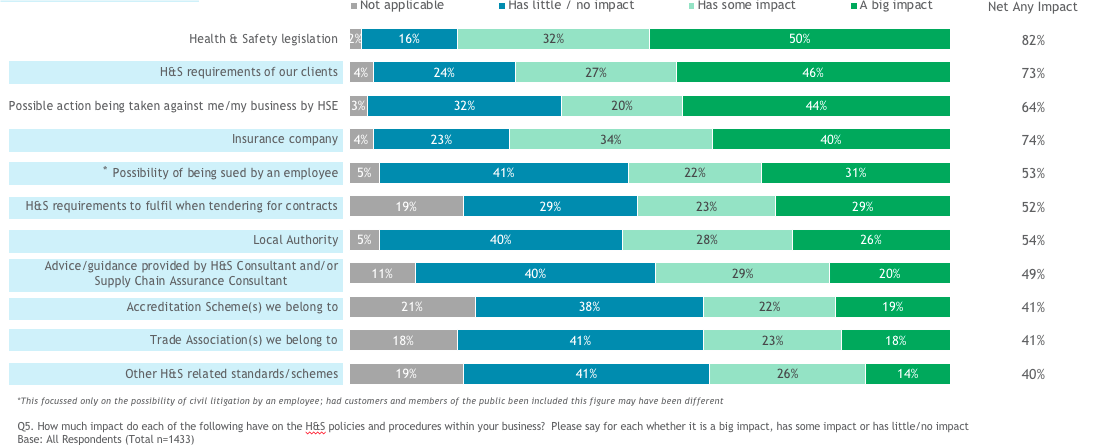Having published Part 3 on my blog yesterday, I thought it only fair to reproduce the Part 1 and Part 2 that appeared on LinkedIn. I have not updated the text from that published in August 2019 and January 2020 respectively.
In the latest edition of Health and Safety at Work magazine, there is an article with the subheading: ‘HSE fears that disproportionate blue tape damages public faith in regulation’. The article and the HSE report on its website cover a range of subjects including the role of consultants, insurance companies and standards writers/specifiers.
There is a lot of good in the HSE report. Organizations and consultants providing off the shelf solutions and ‘find and replace’ occupational health and safety management systems (OHSMS) deserve to be called out for their fleecing of SMEs who know no better. These small business owners are given the hard sell pitch of ‘you have to do this otherwise you could be in court’ and they perceive a call to action that they cannot resist. When the consultant’s contract ties them in for five years and/or leaves them beholden to them for any updates because their provider claims to own the intellectual property of the organization’s OHSMS this verges on a confidence trick.
By presenting anecdotal evidence of poor and sharp practice I’m sure the HSE hopes to build awareness of how SMEs can better select a service provider. There are many examples of some great work that consultants do in translating complex regulations into routine tasks that an SME can do simply in order to maintain a robust, straightforward OHSMS that, ultimately, keeps people safe.
In their evaluation of research carried out under their direction, HSE has focused on the ‘blue tape’ angle of the burden for SMEs. The data, however, shows a significant majority (59%) of SMEs do not support the statement ‘Sometimes taking responsibility for health & safety just feels like more and more paperwork with no obvious H&S benefit’. My apologies for the double negative, down to the When Did You Stop Beating Your Wife way the question was posed and 59:39 disagreed. We have voted to leave a trade bloc constituting around 50% of our exports with significantly lower margins, so if 59% of respondents do not think there is a problem, why is it an HSE focus?
This isn’t to say that SMEs who rail against blue tape should just ‘get over it’ but you would hope for a more balanced presentation on UK business’ view on bureaucracy and regulation.
Burdens by sector and size
In the insight research sample, business sectors reporting that they felt strongly that they are more burdened are:
- Agriculture & Forestry (29% strongly agree);
- Construction (27% strongly agree);
- Administration & Support Services (26% strongly agree);
- Accommodation & Food Services (25% strongly agree);
- Transportation & Storage (24% strongly agree);
- Wholesale & Retail; (25% strongly agree); and
- Repair of Motor Vehicles (25% strongly agree).
By way of comparison the sectors with the worst health and safety accident records, according to the latest published HSE figures are:
- Agriculture, forestry, and fishing
- Water supply; sewerage, waste management, and remediation activities
- Construction
- Accommodation and food service activities
- Transportation and storage
- Public administration and defence; compulsory social security
- Manufacturing
- Wholesale and retail trade; repair of motor vehicles and motorcycles
Now the correlation between the two groups appears significant. To draw definite conclusions is probably not wise but perhaps a little more bureaucracy might bring the accident statistics down?
Later in the report, the HSE reports that certain sectors (including many of the burdened/dangerous sectors above) feel there is no real link between what they have to do to meet others’ demands and what they need to do to keep employees safe. That may well be valid. Surely the HSE should encourage further research into why these dangerous sectors feel this way and what they can do better instead of campaigning against blue tape?
Finally, with regard to the HSE report, those surveyed are asked about how much particular types of rules affect their policies and procedures and the researchers present the data below on the basis of adding together those who report ‘some impact’ and those that report a ‘big impact’. Represented below:
An alternative take on these data is that the following sources of requirements had little or no impact on respondents’ health and safety policies and procedures:
- Health and Safety legislation – 16%
- Client requirements – 24%
- Possible HSE action – 32%
- Insurance company – 23%
- Possibility of civil action – 41%
- Contract tender requirements – 29%
- Local authority – 40%
- Consultant advice – 40%
- Accreditation schemes – 38%
- Trade associations – 41%
- Other standards/schemes – 41%
Is that not more worrying? Almost one in 6 SMEs thought that their legal obligations had no effect on the systems they were using. Also, flying in the face of the HSE drive on blue tape, 40% of respondents did not believe their consultant’s advice had much impact.
The conversation is worth having but the presentation in the HSE report and the Health and Safety at Work article warrant critical scrutiny before H & S professionals start to march behind the ‘rid the UK of Blue Tape’ banner.
Does the HSE have any responsibility for this SME perception? As the regulator, it has a dual role, to educate and to prosecute. Where does the balance in duties rest? If you look at its press releases the overwhelming news is of its role as a prosecutor and this builds a negative perception of HSE and encourages SMEs to protect themselves to avoid being on the growing list of successful HSE prosecutions. What about the supply chain? A search of HSE press releases for ‘contractor management‘ gives an overwhelmingly negative picture of prosecutions. On the main site, there is more balance and good guidance. Throughout, the HSE’s message is one of an organization’s duty to ensure the competence of any contractor/subcontractor and that, understandably leads to the imposition of requirements on those working on their behalf.
Regarding ISO 45001, the HSE’s page on the use of the standard provides a balanced view of the standard. As in the Health and Safety at Work article standard writers are keen to ensure ISO 45001 can be applied by organizations of all shapes and sizes. I believe there are more requirements for documentation under UK law than by the standard. When I train or advise customers about implementing an OHSMS I tell them that compliance with UK statutory requirements gives them 80% of an ISO 45001 system.
The principle of absolute duty of care enshrined in UK Health and Safety Law can be seen to encourage a binary thought process safe/unsafe, compliant/noncompliant, particularly if the organization is a micro or small enterprise they become easy prey for the ‘don’t let yourself be in the dock in front of the judge in her wig’ pitch. The HSE would better serve the SME audience if it promotes a balanced understanding of its dual role of education and enforcement rather than indulge in broad, populist attacks on the industry that has grown up around passing on its health and safety message.
https://www.healthandsafetyatwork.com/feature/singing-the-safety-blues


Leave a Reply